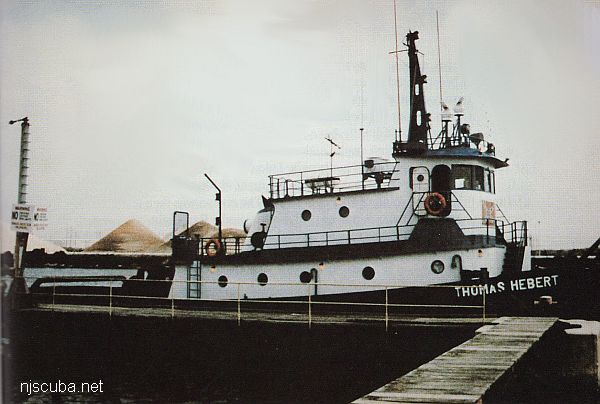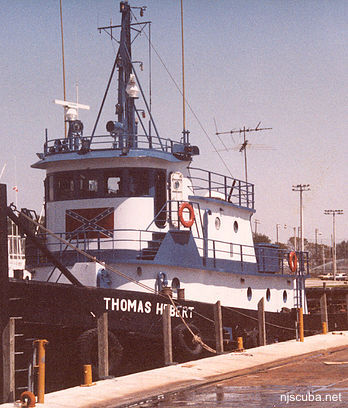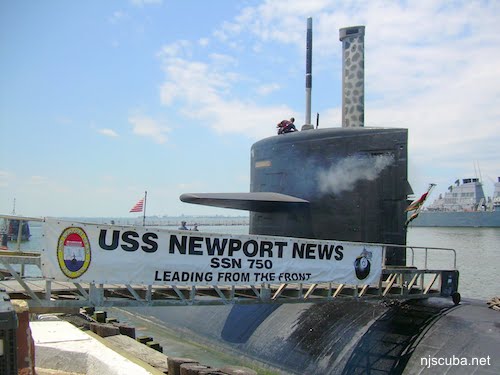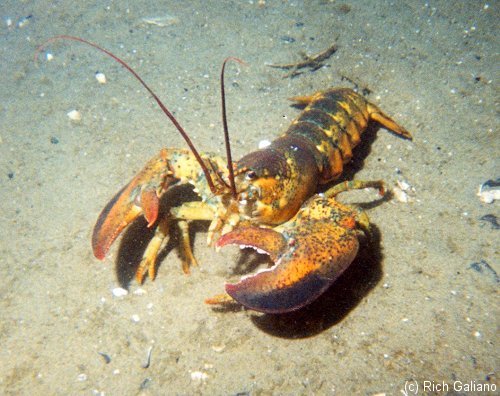Thomas Hebert (1/2)

- Type:
- shipwreck, tugboat
- Built:
- 1975, Orange TX USA
- Specs:
- ( 89 x 27 ft ) 99 tons, 7 crew
- Sunk:
- Sunday March 7, 1993
cause unknown - two survivors - Depth:
- 140 ft
Thomas Hebert was an ocean-going tugboat that sank off the New Jersey coast with the loss of five lives at 3am on Sunday 7 March 1993. She had left Virginia for Maine on 5 March 1993, towing a barge carrying 8,500 tons of coal. Built in 1975 in a shipyard in Orange, Texas, the tug measured 94 ft x 27 ft, displaced 99 tons, and carried a crew of 7. She was last owned by S.C. Loveland Co. of Pennsville, New Jersey.
The sunken vessel was found intact, still attached by a steel cable to the floating barge that she had been towing. The cable showed traces of foreign metal, suggesting that another vessel snagged the tow cable, pulling the tug under, in an incident similar to that of the submarine USS Houston sinking the tugboat Barcona in 1989. She is now completely upside-down and sunk into the mud.

Tugboat Tangled In Mystery
December 01, 1996
By WILLIAM H. MCMICHAEL
Daily Press
There are three theories why the tugboat Thomas Hebert suddenly sank off the coast of New Jersey in the predawn hours of March 7, 1993.
Investigators point to a paper trail of repair records and physical evidence to support their theories.
But the truth about why the tugboat sank, taking five men to their doom, remains a mystery - and, perhaps, one never to be solved.
One investigator speculates that faulty steering caused the tug to turn so suddenly and sharply that it took on water at the stern and sank itself. Another says the tug steered itself in a larger circle in the middle of the night and was passed, then pulled backward and under, by the coal barge it was towing from Newport News to Portland, Maine.
But a third theory, reached by a group of investigators hired by the barge company's law firm, continues to gnaw at survivors, relatives of the dead crewmen, and others. The 89-foot tugboat, these experts say, was pulled under the cold Atlantic waters when a submarine just below the surface snagged its tow cable.
"It went down like a rock," said Brett Cooper, of Ruskin, Fla., the tug's mate and one of the disaster's two survivors. "My theory is that the sub got it."
The S.C. Loveland Co., the New Jersey company that operated the tug and owned the barge, settled with families seeking compensation for the loss of the crewmembers in 1995. But Loveland's former chief executive officer agreed with Cooper. "Past experience, discussions with the two surviving crew members, and the speed with which the Thomas Hebert went down all point to a submarine," George Greaves told the Coast Guard.
And the father of one of the five crewmen who died swears that he walked aboard the very submarine that caught the cable the day after it was brought into Newport News Shipbuilding for what were billed as routine repairs.
The Thomas Hebert was an old salt of a tug. Built in 1975, it was a veteran of the four-day coal barge run to Maine, a trip it made every eight to 10 days. Its captain, since 1986, was William E. "Sweet Willy" Landers, of Elizabeth City, N.C.
The tug rotated three crews; the six men sailing with Landers on this go-round were a seasoned bunch. "That's the most experienced crew we had on the boat," Cooper said.
On March 7, the Thomas Hebert was two days out of Newport News, on the front end of a 2-inch-thick, 1,200-foot steel cable, towing a barge loaded with 8,500 tons of coal. It was a chilly, calm, moonlit morning. The tug was about 35 miles east of the New Jersey shore, moving at about 5.5 knots.
The crew had shifted responsibilities at midnight. Mate George Coram, of Theodore, Ala., due to retire shortly, took the watch from Landers and Cooper, who'd been on the previous six hours. Assisting Coram were assistant engineer Vincent Blanks Jr., of Gloucester County, and Mabuary "Sonny" Hatch, a deckhand out of Del Rio, Tenn. Cooper, Blanks, and Hatch shot the breeze and watched "Saturday Night Live."
Landers and, later, Cooper retired to their second-floor rooms, a few steps down from the wheelhouse. Also down for the night were Charles Landers, of Elizabeth City, N.C., the engineer and William's brother; and James Westmoreland, a deckhand, and cook, from Norfolk. The tug was on automatic pilot.
Sometime after 3 a.m., Cooper was awakened by the sound of books and supplies sliding off the shelf and hitting the deck. The tug listed to starboard.
He dashed to the wheelhouse; no one was at the helm. Seconds later, he heard William Landers bellowing to take the tug out of gear. Cooper, still groggy from his nap, did so, and the list eased somewhat. At some point, he remembered, the bilge alarm went off, meaning the tug's lowest reaches had taken on at least two feet of water.
Cooper had a "bad feeling" in his gut; he dashed back down the steps and grabbed a survival suit. He remembered hearing Coram yelling from down the steps, "Get out of my way!" He later figured Coram must have left the wheelhouse to go below to grab a cup of coffee, or maybe to check on the problem.
Then, Landers recalled, "All hell broke loose."
The lights went out, and the stern began sinking as cold water rushed into the aft engine room door, which was kept open for ventilation; Cooper crawled upstairs to sound a mayday call. Water and wind blasted through the wheelhouse, shattering the windows and washing Cooper out the starboard door. Out in the water, he struggled to avoid the "push knee" at the tug's bow as it sank beneath the waves.
Cooper found the life raft, which had begun to inflate automatically. William Landers popped to the surface; he'd gone down with the tug but had apparently been blown out a front window.
The rest of the crew was trapped inside. Within seconds - no more than a minute after the first list, Landers figured - the tug disappeared.
While he struggled in the water, Landers saw the red and green bow running lights of the barge, slowly approaching.
Sometime within the next two minutes, by Cooper's estimation, the raft suddenly began rushing toward the bubbling spot where the tug had sunk, "driving through the water like an inner tube with a 10-horsepower motor," said Cooper. The raft was being pulled by the 90-foot breakaway rope, still attached to the sinking tug.
For a moment, they thought they'd also be pulled under. Cooper yelled, "Willie, I'm going for the barge!" Just then, the rope snapped, leaving them alone on the surface.
The wind kept them from reaching the barge, which passed them on its starboard side. The two men were rescued at 11:00 a.m. by a Hampton-based fishing boat, the Miss Mandy, two miles south and nine miles east of the sunken tug.
Cooper quit the waterman's life; he builds docks now. "That's as close as I can get to the water and sleep at night," he said. "Losing all my friends is what really ate me up."
The findings of a Coast Guard investigation released 1 1/2 years after the sinking, were less than conclusive: The Thomas Hebert, it said, "probably" sank when its steering system malfunctioned and the barge passed it by and pulled it under.
But the Coast Guard readily admitted that the cause of the sinking "may never be known."
The Coast Guard also concluded that lives could have been saved if the tug had been equipped with an emergency tow release mechanism, which would have allowed someone in the wheelhouse to release the cable.
George H. Reid, an expert in barge operations hired by lawyers for some of the dead mariners' families, said the barge had nothing to do with the tragedy. While also finding no "definitive cause" for the sinking, Reid said a steering malfunction likely related to an electrical problem caused the tug to go "hard over" to the right, and that the power generated by its twin 1,200-horsepower engines caused the tug's stern to dip and sink.
"Unseaworthy conditions caused the sinking of this vessel," Reid wrote.
The tug had undergone a string of repairs related to its electrical system. In April 1992, the starboard generator was overhauled. In June, a generator was "hunting," or failing to run at constant speed, and was adjusted. In August, a generator failed to handle a normal load.
In October, a generator was again found to be "hunting." In November, an exhaust fan motor was replaced. In January 1993, two marine electricians repaired a generator problem. In February, the tug's port radar developed problems, and the port generator was overhauled.
That same month, the Thomas Hebert's autopilot went out near Boston, requiring a repair. On another occasion, one of the solenoids that operates each of the tug's steering pumps failed, causing a five-degree starboard turn. Landers said the problem was quickly corrected when he flipped a switch and began running on the other pump.
If the tug did go "hard over," survivors said, it isn't borne out by the available evidence.
On the ocean floor, the tug lies on its starboard side, very nearly upside down. One rudder is turned to 5 degrees port, while the other appears to be amidships. Landers and Cooper say the positions of the rudders prove that nothing failed. When the flow of electricity is cut to the rudders, Landers said in a deposition, "them rudders aren't coming back. They'll jam over. They'll jam over until you relieve the pressure."
"Why are the rudders amidships on this boat?" Cooper asked. "It just seems pretty improbable for the bottom to beat them into amidships."
The barge company's investigators, and others, say both groups are wrong. They believe a submarine did the deed.
Edward V. Cattell, of Cherry Hill, N.J., the lead attorney for S.C. Loveland, said much time and effort was spent in an effort to get the Navy to admit any involvement in the incident.
In a 1993 response to a Freedom of Information Act, or FOIA, request from S.C. Loveland, the Navy said none of its subs were near the accident site: the USS Archerfish was nearly 140 miles south, and the USS Newport News was about 300 miles south. ( Editor's note: the Navy could be lying. )

The Navy had earlier told the Coast Guard essentially the same thing. The Thomas Hebert lies on the continental shelf, under about 145 of water. "Fleet submarines would not normally be traveling beneath the ocean's surface in such shallow water," the Navy said. But the region where the tug sank was used for sub training, the Navy told the Coast Guard.
The Navy also told the S.C. Loveland Co.'s investigators it had no record of NATO submarines operating in the area on March 7. And if the Navy knows whether any non-NATO subs were in those waters, it isn't saying so; such information, it said, was classified and "exempt from disclosure."
In addition, Cattell said, the Navy told him its sub commanders have orders not to dive unless the water is at least 180 feet deep.
Current standard operating policy, according to the Atlantic Fleet Submarine Force, is that U.S. submarines cannot submerge until they reach the "100-fathom curve" on the edge of the continental shelf. "Anything beyond that is something they don't discuss," said Lt. Cmdr. Mark McCaffrey, a spokesman.
Finally, Cattell said, "There was no damage on the USS Newport News that was consistent with the damage one would expect to see on a submarine that caused a tug to sink. We concluded that we have no basis for the claim."
Cattell is convinced the Navy was not involved. But, he said, there's no doubt it was a sub. "The only object in the entire world that could have created such a force would be a submarine," he said. "It could have been a whale, but so far, we haven't found any with stainless steel plates in their heads."
He figures a foreign sub pulled the Thomas Hebert under the waves.
The prime piece of evidence pointing to a submarine's involvement is the tow cable - basically a 2-inch-thick steel wire rope.
Two months after the sinking, nearly all of the Thomas Hebert's 1,200-foot cable was spooled up to the surface.
Campbell Laird, a University of Pennsylvania metallurgist hired by Cattell to study the cable, found that a 300-foot length on the barge end of the cable displayed heavier corrosion than did the rest. It also curled and looped, Laird said.
Such a steel cable normally lies completely flat when spooled out. When investigators cut the cable at a point 200 feet from the barge end, both ends recoiled into tight curls nearly four feet in diameter.
Laird likened the curling to the spirals one creates by drawing a gift-wrap ribbon across a scissors blade.
One 48-foot section, beginning 304 feet from the barge, was curled more severely, Laird said. When it was cut from the rest of the cable, the entire 48-foot length recoiled into a tight spiral. When cuts were made elsewhere in the cable, those pieces lay flat, Laird said.
The curling of the cable, concluded engineer Donald L. Pellow, who was hired by Cattell, was caused by "severe abrasion of the cable against a hard radial object."
In addition, the zinc coating of the 48-foot section was severely damaged. On the abraded regions on the exterior surface of the coil, a material known as Martensite - formed when steel is rapidly heated to white-hot temperatures and then cooled - was found. The section was also covered with a layer of high-chromium stainless steel that had melded with the steel of the cable.
Therein lies another puzzle. The pressure hulls of Navy submarines, which are covered over with black rubber tiles, are forged with HY-80, a high grade of stainless steel. But it contains only 1.9 percent chromium, Naval Sea Systems Command officials said.
Laird said it may be possible that other components of an L.A.-class sub, such as the sail, may contain higher percentages of chromium, which is added to steel to prevent corrosion - or that foreign subs could use more of the material. Navy officials didn't respond to a query on other L.A.-class sub components in time for publication.
Regardless, the cable damage "wasn't where the tug could have fouled it," said Bruce Belousofsky, a naval architect with Blancke Marine Services of Woodbury, N.J., who was hired by Cattell.
A third large object must have caused the damage, he said. "It was almost as if some monstrous force had pulled it down," Belousofsky said.
Laird believes the force that pulled the tug under was a submarine - although not necessarily a U.S. sub. "If you believe the survivors - and their story is supported by the objective evidence on the cable - I think it's cut-and-dried," Laird said.
The Coast Guard explained the cable damage by noting that the worst of it occurred at a point that would equal the distance from the front of the barge to its stern. If the barge was dragging the tug along, the cable would have rubbed against the bottom of the barge, abrading the cable.
Laird acknowledges that friction from the barge could have created Martensite. But given the cable's catenary, the arc the cable would follow between barge and tug - it would have dipped about 50 feet underwater at its deepest point, survivors and some experts said - "there's no way the barge could have run over the cable," Cattell said. Besides, he noted, "there's no stainless steel on the barge."
The Coast Guard also noted that the cable had gray paint scrapings on it, and that the barge was gray. But an X-ray analysis of samples from both, Laird said, showed that the paint on the cable does not match the paint on the barge.
"All of that evidence goes against the Coast Guard's conclusion," Cattell said.
The sub theory is not without precedent. In June 1989, the Los Angeles-class sub USS Houston caught a tow cable trailing behind the tugboat Barcona off the coast of Long Beach, Calif., and dragged the tug under the surface. The accident occurred the day before the Houston was to take part in the filming of the Cold War sub thriller, "The Hunt for Red October."
The similarities between the two accidents, as recounted in the National Transportation Safety Board, or NTSB, report on the sinking of the Barcona, are eerie.
At 5 a.m., the Barcona, towing two barges in tandem, began acting up, then suddenly listed starboard; the engineer later said it felt as though the rudder had gone "hard over." The tug's stern then began sinking at a dramatic angle. The lights went out, and water crashed into the wheelhouse from below, shattering the windows.
The Barcona sank within a minute. One crewman died; two survived.
What happened: As the Houston rose to a depth of 65 feet - just enough to extend its periscope above the surface - its radio antenna snagged the lead tow cable. When surface lights were spotted, the sub executed an emergency dive at full power and pulled the tug under, the NTSB said.
The NTSB concluded that the Houston's navigation watch failed to use active sonar before ascending to periscope depth.
By survivors' accounts, the only real difference between the sinking of the two tugs was the depth of the water. The Barcona sank to a depth of 2,880 feet.
The sinking of the Barcona, the NTSB noted, caused minimal damage to the Houston. The fiberglass fairing for the radio antenna was ripped open, and the mast was deeply scored where the towing cable had rubbed across it. The repairs cost $145,000.
The attorney for some of the families of the Thomas Hebert's dead crewmen, Ross Diamond of Mobile, Ala., doesn't buy the sub theory. He thinks the findings of Cattell's experts - Belousofsky, Laird, a hydrodynamicist, Pellow and another engineer - are wrong.
"What a bunch of nonsense," said Diamond. A 360-foot sub, 73 feet tall from keel to antenna, trying to dive in 145-foot water, he said, is "going to be in the bottom before it pulls the tug under." If an underwater sub was traveling on a level plane and caught the tow cable, he said, "it would have pulled the tug backwards" - but not under, he maintained.
Diamond, who said the stainless steel on the cable "more than likely came from wrapping around the propeller of the tug as it went down," believes Reid's theory that the tug turned so sharply it sank itself.
Vincent "Chippy" Blanks, of Gloucester County, whose son died aboard the Thomas Hebert, is sure a submarine snagged the tow cable. And he thinks he knows which one: not an unseen and elusive foreign sub, but the L.A.-class, Norfolk-based USS Newport News. The Navy and Newport News Shipbuilding, he maintains, are covering up a scandal.
The Newport News returned to Norfolk Naval Base on March 19, 1993, 12 days after the Thomas Hebert sank, following operations in the Atlantic. It was moved to Newport News Shipbuilding on March 31 for a previously scheduled maintenance period.
Blanks helped schedule repairs at the shipyard, and he had heard scuttlebutt about the sub's possible involvement in the tug's sinking. The morning after the Newport News was placed in what he and another witness said was a covered drydock, he said, he walked aboard and saw substantial damage to the forward section of the sub's sail and what appeared to be patchwork repairs to the sub.
"It had a freshly painted upper rudder," Blanks said. "The rest of the boat had surface scum on it. The rudder didn't. And on top of the sail, the rubber was torn off. It was mangled on the very front corner," he said.
"I knew right away that something had to have mangled that rubber up."
In its FOIA response, the Navy wouldn't say whether any work had been performed on the sub at Norfolk. But if it was, the Navy said, it was performed by the ship's crew and consisted of routine maintenance and preparation for the upcoming shipyard work.
In a 1994 deposition, Leroy L. Slate Jr., then the Newport News shipyard's manager of submarine repair and now manager of all submarine construction at the yard, said that he was not aware of "extraordinary damage" to the Newport News. He also said he didn't recall any sub being brought into the yard in the spring of 1993 with a freshly painted rudder.
The repairs to the Newport News noted by Slate included two gouges in the sail above the port side's fair water diving plane ( the horizontal, wing-like structures on each side of the sail ). One gouge was 1/2-inch wide and 1/4-inch deep, the other 1/4-inch deep and wide. Slate also pointed out dents on parts at the rear of the sub. And the sub's inspection report shows numerous missing rubber tiles on the port side of the sail, above the fair water diving plane, and on the upper rudder.
But in his deposition, Slate said of the missing tiles and other damage: "I saw nothing that I would say was above normal wear and tear and use."
There, the story comes to an abrupt and unsatisfying end.
If the Thomas Hebert's own mechanical problems caused its demise, the evidence was either damaged during the sinking or is irreversibly fouled after nearly four years of underwater exposure. If the sinking was caused by another vessel, those who know the truth remain as silent as the tugboat itself.
"I think eventually somebody will have to say something," said Betty Blanks, Vince Jr.'s mother. "No one can live with things like that forever. Eventually, it will come out."
https://articles.dailypress.com/1996-12-01/news/9612010128_1_coal-barge-tug-tow-cable


Questions or Inquiries?
Just want to say Hello? Sign the .